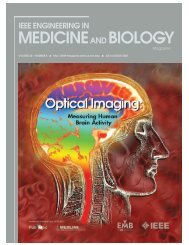Robot Therapy for Elders Affected by Dementia - IEEE Pulse
Robot Therapy for Elders Affected by Dementia - IEEE Pulse
Robot Therapy for Elders Affected by Dementia - IEEE Pulse
You also want an ePaper? Increase the reach of your titles
YUMPU automatically turns print PDFs into web optimized ePapers that Google loves.
58<br />
D of D α<br />
0.0500<br />
0.0400<br />
0.0300<br />
0.0200<br />
0.0100<br />
0.0000<br />
–0.0100<br />
–0.0200<br />
Subject<br />
(Gender, Age)<br />
[MMSE Score]<br />
Score of<br />
Impression of<br />
Paro<br />
A<br />
(M, 72)<br />
[20]<br />
–3<br />
B<br />
(M, 80)<br />
[14]<br />
0<br />
C<br />
(M, 84)<br />
[15]<br />
4<br />
D<br />
(F, 80)<br />
[14]<br />
5<br />
E<br />
(M, 76)<br />
[13]<br />
F<br />
(F, 82)<br />
[18]<br />
6 7<br />
G<br />
(F, 74)<br />
[18]<br />
H<br />
(F, 81)<br />
[17]<br />
I<br />
(F, 79)<br />
[18]<br />
J<br />
(F, 81)<br />
[16]<br />
8<br />
K<br />
(F, 81)<br />
[16]<br />
Fig. 7. The relationship between the impression of seal robot, Paro, and its efficacy on 11<br />
patients.<br />
Fig. 8. Patient K holding a seal robot. She treated it like her<br />
grandchild.<br />
D of D α<br />
0.0550<br />
0.0400<br />
0.0300<br />
0.0200<br />
0.0100<br />
0.0000<br />
–0.0100<br />
–0.0200<br />
Subject<br />
B (M, 80) G (F, 74) J (F, 81) K (F, 81) K (F, 79)<br />
(Gender, Age)<br />
[MMSE Score]<br />
[14] [18] [16] [16] [18]<br />
Score of<br />
Impression<br />
of Paro<br />
–4 3 5 6 7<br />
Fig. 9. The relationship between the impression of Paro and<br />
the efficacy of inactivated Paro on five patients whose neuronal<br />
activities improved <strong>by</strong> the activated Paro.<br />
five subjects: B, G, I, J, and K<br />
(Figure 9). Neuronal activities of<br />
subjects K and I, whose impressions<br />
of Paro were relatively high,<br />
were improved <strong>by</strong> the interaction<br />
with the inactivated Paro. However,<br />
the changes of D a were<br />
smaller than when they interacted<br />
with the activated Paro. In fact,<br />
their interactions with the inactivated<br />
Paro were quite different<br />
from those with the activated<br />
Paro. They rarely touched it, and<br />
never spoke to it. In addition,<br />
none of them said, ‘‘I want to play<br />
more with Paro.’’<br />
Discussion<br />
Art therapy [3], music therapy,<br />
animal therapy, and so on are<br />
known to be effective in delaying<br />
the onset of dementia. However,<br />
these therapies require welltrained<br />
therapists. In addition,<br />
animal therapy has problems of safety and sanitation. Learning<br />
therapy requires patient ef<strong>for</strong>t <strong>for</strong> continuation. Pharmaceutical<br />
treatment is also available to prevent the progress of<br />
dementia but has side effects. In contrast, robot therapy using<br />
the seal robot Paro is safe, convenient, and does not require<br />
special skills, places, or other tools.<br />
In Figure 5, the four patients whose impression of Paro was<br />
most positive were all women. Women interacted with Paro<br />
willingly and treated it as if it was a real puppy or kitten. On<br />
the other hand, most males just watched Paro’s behavior and<br />
did not interact with it positively, even though they commented<br />
that it was cute. One man commented, ‘‘It is boring<br />
because it is not a real animal.’’ Moreover, males generally<br />
feel that playing with stuffed toys is girlish. We considered<br />
that these differences influenced the effects of Paro.<br />
Influences of robot therapy on patients F and G were opposite,<br />
even though their total scores of their impressions of Paro<br />
were the same. Patient G disliked animals but wanted to interact<br />
with Paro. This desire might enhance the effects of Paro,<br />
and she immediately accepted Paro as if it was a real animal.<br />
On the other hand, patient F felt Paro was an artificial thing in a<br />
part of her mind, even though she treated it like a child. We<br />
consider that this difference resulted in opposing influences on<br />
their cortical neuron activity. As <strong>for</strong> patient B, his cortical neuron<br />
activity improved <strong>by</strong> robot therapy despite his poor score<br />
on his impression of Paro. When the experimenter was listening<br />
to patient B’s impression of Paro, people around him<br />
laughed at his negative answer because he interacted with Paro<br />
very happily. His answers to the questionnaire might have<br />
been influenced <strong>by</strong> embarrassment.<br />
As <strong>for</strong> the inactivated Paro, neuronal activities improved<br />
in two subjects whose impression of Paro was relatively<br />
high. Harlow examined the reactions of a child monkey to<br />
two surrogate mother monkeys consisting of only hard wire<br />
or hard wire-covered with a soft blanket [45]. He found that<br />
the child monkey was more attracted to the soft surrogate<br />
mother monkey, and often hugged it. Softness brought the<br />
child monkey com<strong>for</strong>t and peace. This experiment showed us<br />
<strong>IEEE</strong> ENGINEERING IN MEDICINE AND BIOLOGY MAGAZINE JULY/AUGUST 2008



